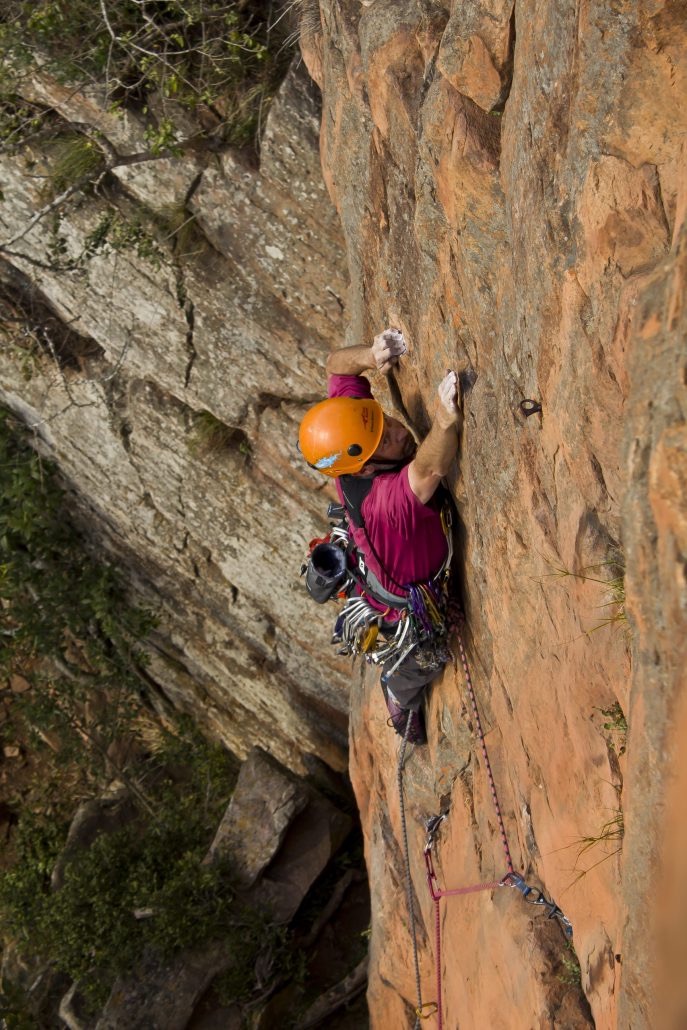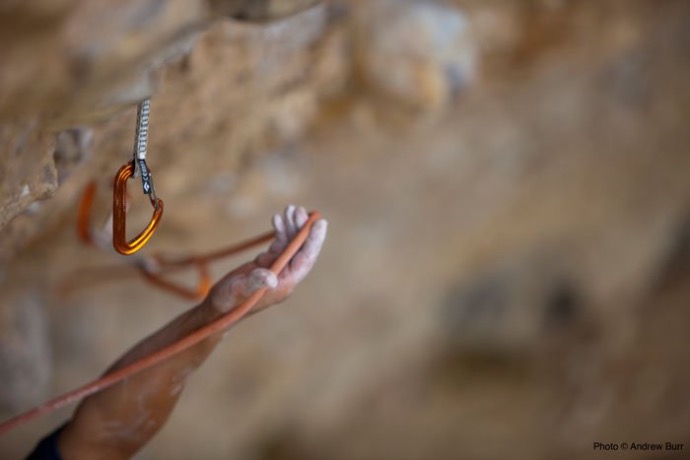Trad climbing essentials:
Trad climbing is arguably the most rewarding form of rock climbing.
The beauty of trad is the amazing depth and breadth of experience that it offers.
You are also not limited to hard grades in order to do something “worthwhile” and there is always an opportunity for new routing or any level of adventure which you choose.
Protection is a necessary inconvenience. Most climbers try to carry the least they need to do the route comfortably. Take too little, too much, or the wrong stuff and eventually you’re guaranteed an epic.
Fifteen draws will get you up most modern bolt-protected routes anywhere in the world. That’s the beauty of these routes – interaction with equipment is minimized. It’s not such an easy formula for routes where natural features provide the only protection opportunities.
Trad Climbing is Not Simple:
Awareness of all the rock’s intricacies, not just the parts with chalk on them, becomes of supreme importance. Different cliffs and rock types provide various opportunities for protection in type, quality, and frequency of placements, so the “ideal rack” will differ from crag to crag. The rack you put together for splitter cracks at Indian Creek will be very different from the selection you use on Lion’s Head granite. That said, there is a fairly standard selection that is core to most racks outlined below. It is also worth mentioning that most experienced climbers will work with their partners to select the best rack for the day’s challenges by selecting gear from both of their racks. This will allow you to carry duplicates of certain sizes as need be.
For most routes, you’ll get a good idea of what gear to take either from the guide, beta from friends, and looking at it yourself. The time when you will really depend on making the best possible guess is for that multi-pitch route about which you know practically nothing. For these occasions, the list below provides a good template for the essential gear for trad climbing from which to start.
Your own judgment and actions rule your life. Add to, remove from or ignore this list as you see fit!
Click Here For a List of Trad Climbing Essentials
Cams, Hexes, and Nuts:
This is the category that scares most climbers due to the expense of cams. However, it’s comforting to recognise that a good set of cams can give decades of service; and once you have a set; your climbing options become almost infinite. There is literally more than a lifetime of climbing in South Africa alone – let alone all the amazing climbing in other parts of the world too.
Cams:
So Cams are expensive, but for good reason. The aluminum has to be incredibly light, really durable and the design has to work 100% of the time.
That said – one can build up a useful rack in manageable bites, and it’s even easier if you co-operate with your climbing partner by both buying complementary parts. I suggest you buy your cams in two phases:
- Step #1 : 1x (0.5, 0.75, 1, 2, 3) Black Diamond C4
- Step #2 : 1 x (0.2, 0.3, 0.4) Black Diamond Z4 + 1 x 4 C4
Hexentrics:
While there are definitely placements for which hexes are ideal; other placements often require that you use both hands to get it seated. For this reason, most experienced trad climbers prefer to use a cam that will fit the same crack & are easier & quicker to place. That said; if budget is the issue – a set of hexes will give you a lot of options & get you climbing while you slowly work on your rack of cams. Hexes are lightweight camming device supplements and cheaper than cams to abandon if necessary.
Stoppers:
(Often called nuts) can be purchased in sets. I would recommend starting out with a basic set and then you can add onto the set with individual nuts.
- Set (size: 4-13)

Slings and Quickdraws:
If you sport climb already you can use your nylon quickdraws although you may want to add some longer ones to your rack. The main differences between lead quickdraws and trad quickdraws are size and weight, trad quickdraws are smaller and lighter.
These recommended wire gate carabiners and runners are ideal for combining into alpine draws (basically light, long quickdraws)
- 10 – 14 Quickdraws
- It is also helpful to have a mix of length; suggest 4-6 x 12cm, 4-6 x 16, or 17cm. Two longer units (25 or 30cm) can also be very helpful.
- 2 sets of Wiregate carabiners colour coded to cams
- 2x 60cm open slings + 1 Wiregate Carabiner per sling
- 2x 120cm open slings + 1 Wiregate Carabiner per sling
- 2 prussic loops – 5mm or 6mm chord

Ropes:
There are two main methods of leading on trad – two thin half ropes – or one single.
Single Rope:
While using a single has the advantage of owning only one rope for both sport & trad climbing; it has a couple of disadvantages:
- Most trad routes wind around looking for the breakthrough difficult terrain. For this reason, as you place gear, you need to be conscious of not creating too many corners for your rope to turn – otherwise, the accumulated friction will stop you in your tracks. In order to ensure a smooth flow on a single rope – you need to make good use of long slings to allow the rope to “cut the corners”. This can often result in feeling exposed to potentially longer falls.
- When abseiling off a route; one has to fold this rope in half – which limits the distance you can descend and increases the number of abseils you have to set up (potentially in awkward places)
Two Thin Ropes: (Half Ropes)
In order to address the above issues, the norm for most trad climbers is to use two thinner ropes which allow you to:
- Run two ropes in parallel while climbing a weaving route around obstacles. The ropes travel as straighter line & friction is minimised
- When descending; you can tie the two ropes together and descend for the full length
There are three additional advantages of this system:
- It allows you to climb efficiently as a party of three (one second on each rope; often climbing simultaneously)
- While buying trad ropes is an extra expense; you only use one set of ropes while climbing – so your sport rope will last a lot longer if it is only used when climbing sport.
- Should you be unfortunate enough to have an accident during which a rope is cut/damaged – having two ropes will give you more options for self-rescue.
When I started climbing, the standard trad ropes were 45m x 9mm. However as gear has improved and climbing standards have risen, there has been a tendency towards longer pitches – often linking pitches together. Jacobs Ladder on Table Mountain is a good example. Originally opened as a four-pitch route, it is commonly climbed in 2 pitches now. Due to this trend, combined with improvements in rope technology – trad ropes have got thinner and longer. The standard is now 60m – 70m ropes of 8 to 8.5mm. So we consider half ropes to be part of the recommended gear for trad climbing.
After many decades of trad climbing my favourite ropes are:
- 2x 60m Half Ropes – Beal Cobra (Most affordable)
Or:
- 1x 60m or 70m Single Rope – Beal Joker (Not good for winding routes)
Or:
- 2x 60m Lightweight Single Ropes - Beal Opera (Safest)

Other:
- Belay device
- Belay Carabiner
- 4x Screw gate Carabiners
- Nut tool
- Harness
- Chalk Bag
- Helmet – on trad routes, this is not an optional extra!
Click Here For a List of Trad Climbing Essentials
Rock Shoes:
The choice of rock shoes is very personal and will vary according to fit and last as well as the characteristics of the route to be climbed. Some folk want the same performance as they get from their sport shoes while others want a more comfortable, supportive fit. It’s worth considering the following:
- For long, moderate to easy routes, a board-lasted shoe will provide more support and will allow solid edging support even with a more relaxed & comfortable fit.
- For climbing harder routes, a softer, more sensitive shoe may be required. Should this be the case; it’s a good idea to have velcro closure so that you can take them off/ put them on easily allowing you to remove them after every pitch.
Packs:
Trad climbing does ask more of a pack – both in volume & features. The ideal size is around 45L which will allow you to stash a rope + rack + water + harness + rock shoes + helmet (and in my case a flask for coffee). Ad this all together & the weight adds up – so the pack itself should be fairly light. That said it needs to be tough and streamlined in order to cope with the scrambles & bush-bashing that is often involved.
If you are considering climbing with a pack – then you need it to be tough, very compact & streamlined with quick, easy access.